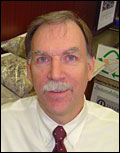
Robert Peoples.
What work do you do?
I run a nonprofit called the Carpet America Recovery Effort, or CARE. I serve as the executive director. I am also the director of sustainability for the Carpet and Rug Institute. Finally, I manage an environmental engineering and consulting company in Florida.
I am a Ph.D. chemist by training. The reason I share this is to establish the idea that I try to deal in facts and information. I love to share and teach. I am not a salesman or a marketing guy. I always tell my audiences that I am a human being just like them. In other words, I breathe the same air, drink the same water, and eat the same foods. I have as big an interest in not fouling those life-giving nutrients as they do!
How does it relate to the environment?
The mission of CARE is to develop market-based solutions for the reuse and recycling of post-consumer carpet. Last year we reported that 261 million pounds of old carpet were diverted from landfills. You can go here to learn more about where this is done and the outlets for these valuable recovered materials.
What are you working on at the moment? Any major projects?
Oh yeah, two biggies. Finding outlets specifically for carpet made from nylon 66 face fiber, and trying to convince people to buy products made from post-consumer carpet — creating demand to justify collections.
It is also probably worth pointing out that this is a big project with no simple answers. So, it really is a team effort. I am very fortunate to work with some very talented people. Also, I have found the carpet industry as a whole to be a very forward-looking group, open to ideas and possibilities. I think this is one of the reasons we have such good working relationships with many states and the U.S. EPA.
How do you get to work?
I am on the road quite a bit, but often telecommute when not traveling. I love to use the transit system in major cities if available. It is like an adventure to me. Some are pretty good. I do recall the time I sat on broken-down transit in sight of the airport control tower while I missed my flight and the next two after it until they finally got us up and running again. That was not much fun! When I have to drive, I use my Mini Cooper.
What long and winding road led you to your current position?
After 23 years in a large chemical enterprise (Monsanto and later its spin-off Solutia), I retired due to a bankruptcy. In the mid-’90s, I was director of technology for nylon and had a team of engineers and chemists working on carpet recycling. This was way before it (or sustainability) was popular. Subsequently we went through a spin-off from the parent, and all work stopped.

A rug’s life.
Photo: iStockphoto
A few years later, I was asked to develop a strategy for recycling for the carpet business team. That resulted in a lot of time in the field, talking to entrepreneurs and getting involved in the original discussions and negotiations that led to a memorandum of understanding between the EPA, about 13 states at that time, and the carpet industry to enter into a voluntary partnership to keep post-consumer carpet out of landfills. I was personally very heavily involved in efforts to help get CARE started and moving forward. That resulted in the offer to become the first executive director of CARE when I left Solutia in December of 2003. In 2004, I was named the first CARE Person of the Year, an honor for which I am particularly proud since it was bestowed by my peers and national colleagues.
Where were you born? Where do you live now?
I was born in Perth Amboy, N.J. I currently reside in Pensacola, Fla., and spent quite a bit of time in Atlanta and Dalton, Ga., when not on the road promoting carpet reclamation.
What has been the worst moment in your professional life to date?
Learning that a great 100-year-old corporation was being dismantled and destroyed by a Wall Street-type lawyer. It adversely affected the lives of tens of thousands of people, many my friends.
What’s been the best?
I think there are really two. The first was being named as the CARE Person of the Year. The second, and much more impactful, was becoming the executive director of CARE where I could fulfill a mission that I am passionate about. We are building a brand new industry in the United States. How often these days can someone say that?
What environmental offense has infuriated you the most?
I think what is happening in China is really terrible. Given what the world leaders and scientific community know about environmental stewardship, it is a crime, and aggressive steps by the international community should be instituted to allow progress, but at the same time avoid and stop this global climatic tragedy.
Who is your environmental hero?
I have really been impressed by what the U.S. Green Building Council has been able to accomplish through its LEED initiative. While not everyone may agree, this effort has brought a ton of focus to the green-building effort on a global basis. It is a living, organic system that is evolving — a very powerful model based on nature’s own systems thinking. On an individual basis, I have been inspired by Paul Hawken and the big man himself, Albert Einstein. I particularly like Einstein’s definition of insanity: doing the same thing over and over again and expecting different results.
What’s your environmental vice?
Spending too much time working on CARE and other environmental initiatives. I have a hard time saying no!
How do you spend your free time (if you have any)? Read any good books lately?
I occasionally fit in a round of golf. I love to read. My recent reads are Lives Per Gallon by Terry Tamminen, The Tipping Point by Malcolm Gladwell, The Change Function by Pip Coburn, and The World is Flat by Thomas L. Friedman. If it relates to science or medicine, it is on my list. Michael Crichton and Robin Cook are also favorites.
What’s your favorite meal?
Anything pasta with a good red wine.
Which stereotype about environmentalists most fits you?
Committed, passionate, and dedicated.
What’s your favorite place or ecosystem?
The beach! It is refreshing to watch a sunrise and particularly relaxing to watch the sun set over the Gulf of Mexico. When I work at the beach it does not seem like work at all and it’s inspirational.
If you could institute by fiat one environmental reform, what would it be?
Make the financial investments necessary to enable true recycling to take place. If we had just a fraction of the money wasted by our government (both federal and state) we would have a completely different future. How about campaign finance reform — 120 days of campaigning. All the money wasted could be put to a much better use! Think of all the people running and how much they will spend without even a whisper of a chance of winning a nomination.
Who was your favorite musical artist when you were 18? How about now?
In college it was Emerson, Lake & Palmer and The Beach Boys. Today, it is anything early ’70s — sure beats the rap crap of today. Check out the musical Jersey Boys — now that’s music.
What’s your favorite TV show?
I have all but given up on TV. I can’t stand spending 30 to 40 percent of an hour listening to commercials. Movie? Braveheart and Bicentennial Man. Robin Williams is insane but brilliant.
Which actor would play you in the story of your life?
If you could have every InterActivist reader do one thing, what would it be?
Make a $10 donation, and ask one friend to do the same, to the CARE organization to help foster our mission of landfill diversion of post-consumer carpet. We’ll acknowledge the total gift on the CARE website.

